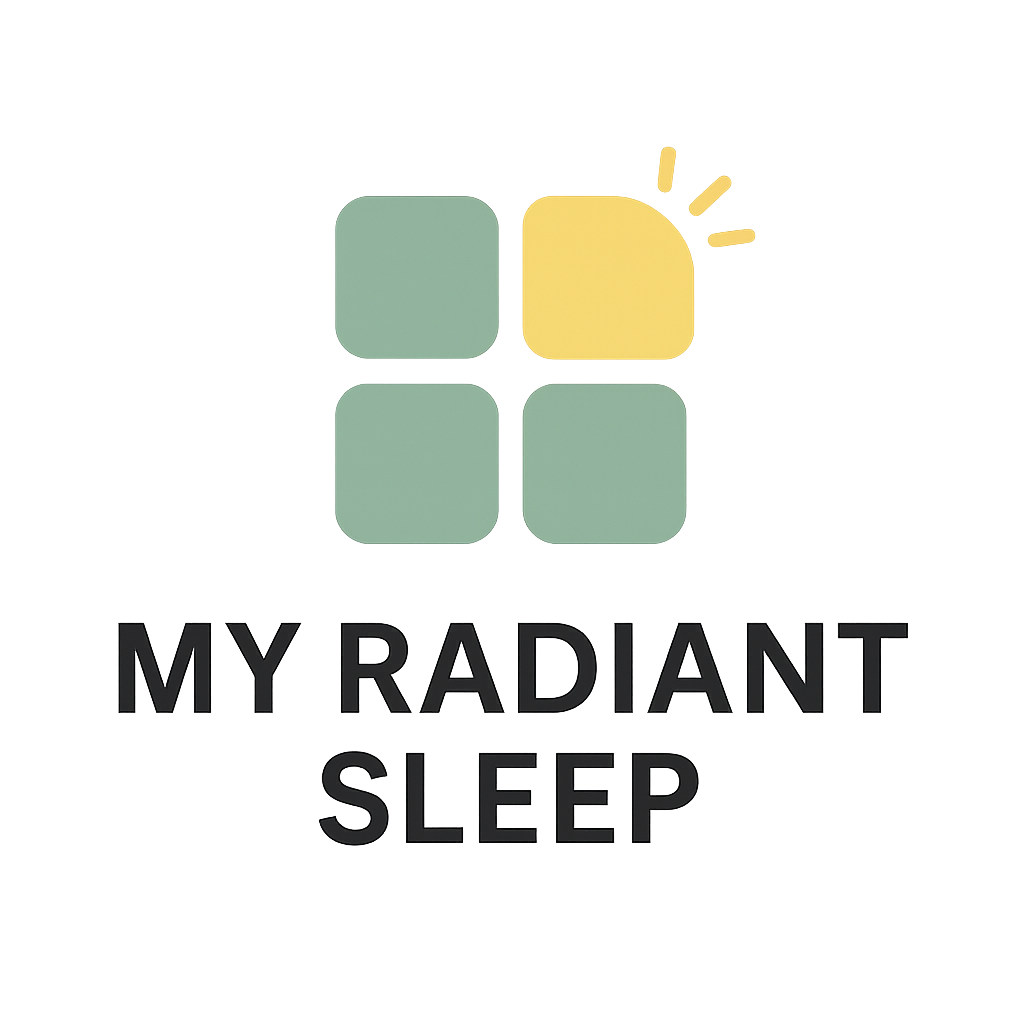(Last Update: 07/04/2025)
KEY TAKEAWAYS
- The history of mattresses and sleep has evolved over thousands of years, shaped by different socioeconomic statuses.
- Innovations in the market and industry have allowed for various options to cater to individual preferences and needs.
- Cultural influences, modern trends, and advancements in technology and materials are expected to continue driving the development of a more enhanced sleep experience.
Did you know that the history of mattresses dates back thousands of years?
The evolution of mattresses, from early humans sleeping in trees to the luxurious beds of ancient royalty, is fascinating.
In this blog post, I will explore how cultural and socioeconomic factors have shaped the development of mattresses from ancient times to the present.
You’ll witness how mattresses have evolved to provide the utmost comfort and support for a good night's sleep.
Join me on this captivating journey through time.
SECTION 1: The Role of Sleep in Human Life and Health
Throughout history, the understanding of sleep has evolved significantly, particularly with the advent of sleep centers and systematic sleep analysis. Sleep was a mysterious and often misunderstood phenomenon in earlier times, with little known about its stages or the underlying mechanisms that regulate it.
- Understanding Sleep-Wake Cycles in Human Beings
The concept of the sleep-wake cycle is fundamental to understanding human health and behavior. This cycle, which governs when we sleep and when we are awake, is a critical aspect of our daily lives.
Historically, the understanding of sleep-wake cycles has evolved significantly. In the early days, sleep was often segmented, with people experiencing 'first sleep' and 'second sleep' periods throughout the night.
However, in the last century, particularly in industrialized countries, the pattern shifted towards a consolidated night's sleep.
Various medical texts and studies documented this change, which reflects human adaptation to changing lifestyles and environmental cues.
As science progressed, researchers began asking why we sleep, leading to profound insights into unconsciousness, REM cycles, and the importance of deep, restorative rest across human history.
- THE ROLE OF SLEEP REGULATION AND HEALTH RISKS
Sleep regulation, a process controlled by the brain, is essential for maintaining overall health. Disruptions or light sleep in this regulation can lead to increased risks of various health issues.
Research from institutions like Stanford University has shown that irregular sleep patterns can contribute to chronic diseases, mental health disorders, and decreased life expectancy.
In the last two decades, there has been a growing focus on understanding the different stages of sleep, including REM (rapid eye movement) and deep sleep, and their impact on the body's vital processes.
Paradoxical sleep is another term for Rapid Eye Movement (REM) sleep, a stage of sleep characterized by rapid eye movements, vivid dreaming, and a high level of mental activity that resembles wakefulness. The term "paradoxical" comes from the fact that, despite the brain being very active, the body's muscles are almost completely paralyzed, preventing the sleeper from acting out their dreams.
This research underscores the importance of maintaining regular sleep-wake cycles for optimal health.
THE ESSENTIAL FUNCTION OF SLEEP IN PHYSICAL AND MENTAL HEALTH:
- Memory Consolidation and Neural Circuits
- Sleep is crucial for memory stabilization, helping to store experiences and learned information in the brain.
- Neural circuits responsible for learning, problem-solving, and emotional regulation are strengthened during sleep.
- Physiological Changes and Overall Well-being
- During sleep, heart rate decreases, and electrical mental activity is regulated, promoting recovery and overall health.
- Sleep deprivation can impair cognitive function, increase stress levels, and weaken the immune system.
- Sleep in the Context of Evolution and Modern Challenges
The study of sleep also extends to evolutionary perspectives, such as the sleep patterns of night-active animals and their influence on human sleep behavior.
Research has delved into how evolutionary needs and environmental factors have shaped our waking and sleeping patterns over the past year.
This research provides insights into how modern challenges, like artificial lighting and shift work, have altered our natural sleep-wake cycles.
As we move into the future, understanding these aspects becomes crucial in addressing sleep-related health issues and improving the quality of life in our increasingly complex world.
During recent decades, distinctions like core sleep and deep sleep recovery reshaped sleep medicine and revealed how sleep architecture evolved alongside advancements in mattress design.
THE IMPACT OF SLEEP DEPRIVATION ON HEALTH
Consequences of Sleep Deprivation
- Sleep deprivation disrupts circadian rhythm, leading to poor sleep quality and shorter self-reported sleep duration.
- Increased risk of chronic conditions, heart disease, obesity, and diabetes is associated with sleep deprivation.
Mental Health Implications
- Lack of sleep contributes to depression, anxiety, and cognitive decline, emphasizing the importance of a healthy sleep structure.
- Having a regular sleep schedule is crucial for physical and mental well-being.
The Evolution of Sleep Research and Medicine
Sleep research and medicine have witnessed remarkable advancements over the years, evolving from a rudimentary understanding of sleep to a sophisticated study of its complexities.
The early days of sleep research were marked by groundbreaking discoveries, transforming sleep from a mysterious phenomenon to a subject of scientific exploration. This marked the dawn of sleep research as a distinct scientific discipline, setting the stage for modern sleep science.
Ancoli-Israel and Roth T, in the American Journal of Sleep Res, emphasized that across different countries, sleep quality is influenced not just by culture, but also by the evolution of bedding.
The large number of mattress innovations—spanning materials, support systems, and comfort layers—has reshaped how we rest.
EARLY DAYS OF SLEEP EXPLOITATION
- Limited Understanding of Sleep's Functions
- Initially, sleep was largely viewed as a passive state of rest with no significant physiological importance.
- Early theories often needed more scientific backing, and sleep was not considered worthy of in-depth study.
- The lack of technological tools initially limited the ability to explore the complexities of sleep, leading to a slow start in sleep research. However, with advanced technologies, sleep research has accelerated, allowing a deeper exploration of sleep's functions and implications.
Technological advances now offer sleep apnea monitors, helping track nighttime breathing—something early humans had no tools to measure or manage.
- Emerging Interest in Brain Activity
- As the scientific community's interest in understanding the brain and its functions grew, sleep became an area of interest.
- The realization that sleep might play a crucial role in overall health prompted researchers to investigate further.
- This newfound interest began a more focused approach to studying sleep, laying the foundation for future discoveries.
Pioneering Neurophysiological Studies in Sleep
The advancement of neurophysiological studies was pivotal in unraveling the mysteries of sleep.
Hans Berger, a notable figure in this field, made significant contributions with his invention of the electroencephalogram (EEG): it allowed researchers to study mental activity during sleep for the first time.
This breakthrough provided invaluable insights into the biological clock that regulates sleep-wake cycles, opening new avenues for understanding how the brain functions during different sleep stages.
The Impact of Sleep on Brain Function
Sleep research reveals that constant darkness can induce and inhibit sleep depending on the alignment of body clock. During the first sleep cycle, the brain undergoes significant changes in electrical activity, which are crucial for cognitive restoration.
This period of nighttime sleep is vital for memory consolidation and learning. Understanding these processes helps develop better sleep medicine strategies to enhance overall sleep quality.
With innovations like cooling gels and recovery foams, beds like the Molecule Mattress represent a scientific leap from hay, cotton, or feathers.
Enhancing Nighttime Sleep
Sleep and circadian rhythms are essential in regulating total sleep time and sleep and wakefulness patterns. According to sleep research, maintaining a longer nighttime sleep duration is necessary for optimal brain function.
Sleep medicine emphasizes that quality sleep, where individuals fall asleep quickly and stay asleep, can significantly improve mental and physical health by allowing the brain size to recover effectively.
Many humans once viewed sleep as mere unconsciousness brought by night. But in recent decades, a greater awareness has emerged—thanks to institutions like the National Institute of Health and the National Academy of Sciences.
Sleep is now understood as a dynamic state of sleep and wakefulness, affecting the health of millions of American adults.
The modern push for sleep hygiene recognizes that creating the perfect sleep environment—including mattress and pillow choice—can significantly improve both comfort and circadian regulation.
HANS BERGER'S CONTRIBUTION TO SLEEP SCIENCE
- Invention of the Electroencephalogram (EEG)
- Berger's development of the EEG was a groundbreaking achievement that revolutionized the study of sleep.
- The EEG allowed researchers to monitor and record electrical activity in the brain during sleep, revealing the dynamic nature of the sleeping brain. This tool provided the first real-time insights into the various stages of sleep, including the discovery of REM and non-REM stage. This, in turn, led to the development of treatments aimed at improving sleep quality and addressing sleep disturbances.
- This tool provided the first real-time insights into the various stages of sleep.
- Understanding the Biological Clock
- The EEG enabled researchers to identify the brain's biological clock regulating sleep-wake cycles.
- By observing mental activity, scientists could map out the different stages of sleep and understand their significance.
- This understanding paved the way for more advanced studies into how sleep affects overall health and cognitive function.
While old-world beds lacked flexibility, today’s adjustable firmness mattresses allow users to fine-tune their experience, revolutionizing personalized rest.
Key Contributions by Sleep Research Pioneers
The mid-20th century marked a period of groundbreaking work in sleep research, driven by pioneers like Nathaniel Kleitman and Eugene Aserinsky.
Their discovery of Rapid Eye Movement (REM) sleep revolutionized the field. Contrary to previous beliefs, the brain remains active during sleep. This discovery laid the groundwork for further research into the different stages of sleep and their implications for health and disease.
Colin Sullivan's development of Continuous Positive Airway Pressure (CPAP) therapy for obstructive sleep apnea also marked a significant milestone, showcasing the practical application of sleep research in treating sleep disturbances.
Their work underscores the value of translating sleep research into clinical practice, benefiting millions of patients worldwide.
THE DISCOVERY OF REM SLEEP
- Nathaniel Kleitman and Eugene Aserinsky
- Kleitman and Aserinsky's discovery of REM sleep was a turning point in sleep research, challenging the notion of sleep as a passive state.
- REM sleep was identified as intense mental activity, known as rapid eye movements and vivid dreams.
- This discovery led to a deeper understanding of the role of different sleep stages in memory stabilization, emotional regulation, and overall brain health.
- Implications for Health and Disease
- Identifying REM sleep opened up new avenues for researching sleep's impact on physical and mental health.
- Studies began to explore the link between REM sleep and various health conditions, including depression, anxiety, and neurodegenerative diseases.
THE DEVELOPMENT OF CPAP THERAPY
- Colin Sullivan's Breakthrough
- Colin Sullivan's invention of CPAP therapy provided a revolutionary treatment for obstructive sleep apnea, a condition that disrupts breathing during sleep.
- CPAP therapy delivers a continuous stream of air through a mask, keeping the airway open and preventing interruptions in breathing.
- This innovation demonstrated the practical application of sleep research, significantly improving the quality of life for those with sleep apnea. It also serves as a testament to the potential for further advancements in sleep medicine, offering hope for improved treatments and outcomes.
In clinical sleep medicine, studies now show how mattresses impact sleep quality and overall health by influencing spinal alignment, pressure relief, and long-term cardiovascular and neurological outcomes.
IMPACT ON SLEEP MEDICINE
- CPAP therapy became the gold standard for treating obstructive sleep apnea, which is the importance of sleep medicine in addressing sleep disturbances. The success of CPAP therapy spurred further research into other sleep-related conditions, leading to advancements in treatment options and significantly improving the quality of life for those with sleep irregularities.
- The success of CPAP therapy spurred further research into other sleep-related conditions, leading to advancements in treatment options.
- Sullivan's work underscored the value of translating sleep research into clinical practice, benefiting millions of patients worldwide.
THE ROLE OF SLEEP AND CIRCADIAN RHYTHMS: THE SUPRACHIASMATIC NUCLEUS
- Circadian Rhythms and Sleep Regulation
- The body clock, controlled by the suprachiasmatic nucleus (SCN), regulates sleep and wakefulness in a 24-hour cycle.
- The circadian pacemaker synchronizes the body's internal clock with environmental cues like light and darkness.
- Disruptions and Health Consequences
- Exposure to artificial light and shift work can disrupt body clock, leading to sleep irregularities.
- Understanding molecular mechanisms behind circadian rhythms is crucial for developing effective sleep treatments.
- Modern Sleep Science: Principles and Practice
Today, sleep science is an interdisciplinary field encompassing various aspects of medicine, psychology, neurology, and sleep physiology.
The principles and practice of sleep medicine now involve a comprehensive approach to diagnosing and treating sleep disturbances, informed by decades of research.
Current sleep disturbances research continues to build on the legacy of early pioneers, using advanced technology to study sleep and its impact on overall health.
This ongoing research is crucial for developing new and effective sleep disorder treatments and furthering our understanding of this vital physiological function.
Section 2: The Evolution of Sleep
( Cultural Influences on Beds and Mattresses)
Cultural influences have significantly shaped the evolution of sleep, beds, and mattresses. African, Middle Eastern, Eastern, and Western cultures exhibit distinct preferences for sleep surfaces and bed designs. Eastern cultures like Japan favor futons and daybeds, while Western cultures lean towards four-poster beds and canopies.
Cultural preferences extend beyond design and materials to sleeping locations, partners, and sleep schedules. This diverse range of cultural practices highlights how the richness of human experiences has profoundly influenced the development of sleep and beds over time.
- The Etymology and Meaning of the Word "Mattress."
The word "mattress" comes from the French word "matelas" and the Arabic word "matrah." The first mattresses were made from straw, hay, and feathers. The Arabic word "matrah" means "something thrown down.” This is likely because the first mattresses were made from straw or hay, easily thrown down on the ground.
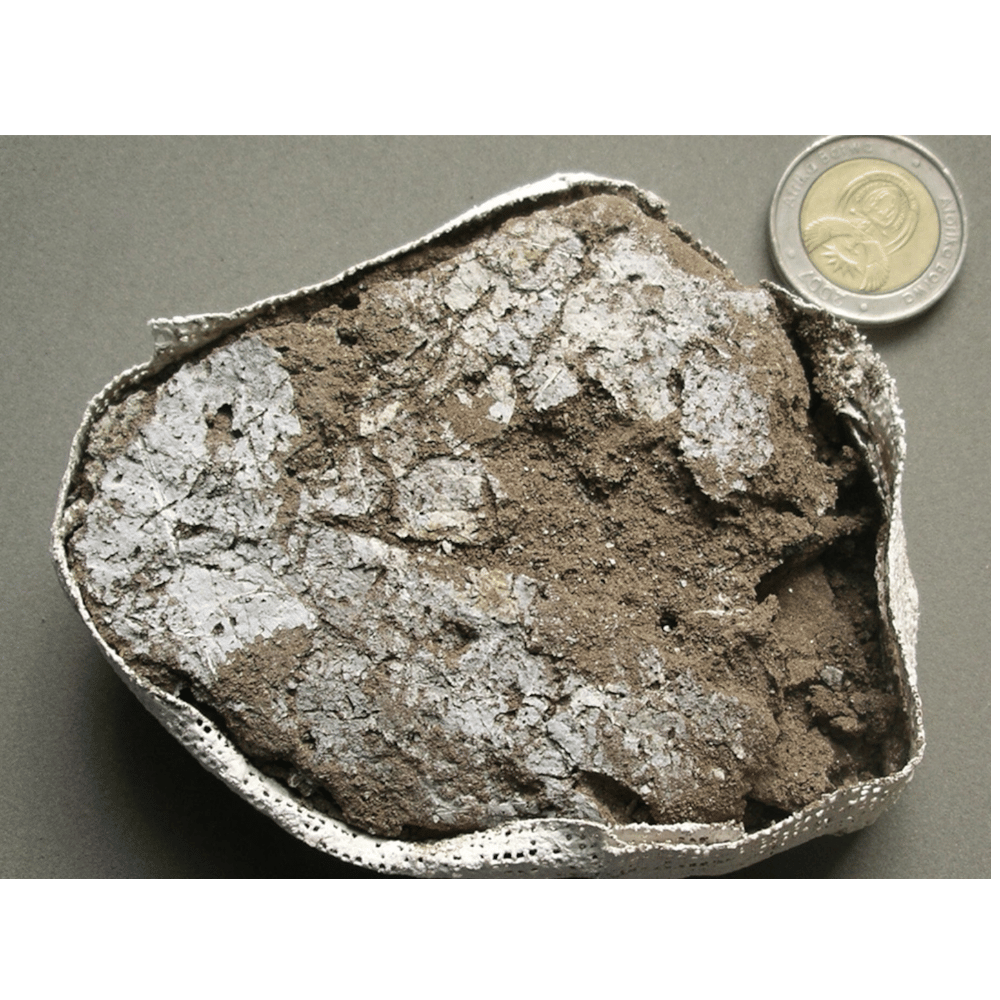
The Prehistoric Period: (The Oldest Known Mattress (77,000 Years)
From the first mattress of human sleep patterns to the early medieval period to the luxurious beds of ancient civilizations and the Western world, the evolution of sleep and the history of mattresses span thousands of years.
The Sibudu rock shelter in South Africa is related to the first-ever mattress. In 2012, archaeologists discovered a 36-inch by 72-inch by 3-inch thick mattress made of compacted layers of plant material and grass at the Sibudu rock shelter.
Early humans initially resorted to sleeping in trees in prehistoric times, seeking safety from predators. As they evolved, they transitioned to sleeping on the ground. The oldest known "bed" dates back approximately 77,000 years ago and was discovered in KwaZulu-Natal, South Africa, making it the oldest known mattress worldwide. Early humans would sleep on a pile of leaves or grass mounded into a depression in the ground.
The Prehistoric Period: Sleep in the Animal Kingdom
- Segmented Sleep Patterns
- Early humans and animals often practiced biphasic sleep, with periods of wakefulness for monitoring predators.
- The natural light-dark cycle guided sleep patterns, ensuring a balance between rest and vigilance.
- Circadian Modulation in Prehistoric Times
- Circadian modulation plays a significant role in shaping early sleep patterns in the animal kingdom.
- Survival requires the regulation of sleep based on environmental factors and threats.
The rise of bed-in-a-box mattress shipping marked a turning point in how people accessed quality beds—offering convenience without sacrificing comfort, even for larger sizes and foam models.
Let's explore the different periods and their contributions to developing beds and sleep.
ANCIENT EGYPT
Ancient Egypt made significant contributions to the history of beds. Ancient Egyptians constructed raised beds with surfaces made of plain wood, keeping pests and snakes away from their feet. Ancient Egyptians raised beds by piling soil, sand, and sometimes linen sheets with stones or bricks. They added reeds, rushes, and straws to create comfortable sleep surfaces.
They constructed raised beds with plain wood surfaces, keeping pests and snakes away from their feet. They also piled soil, sand, and sometimes linen sheets with stones or bricks. They added reeds, rushes, and straws to create comfortable sleep surfaces.
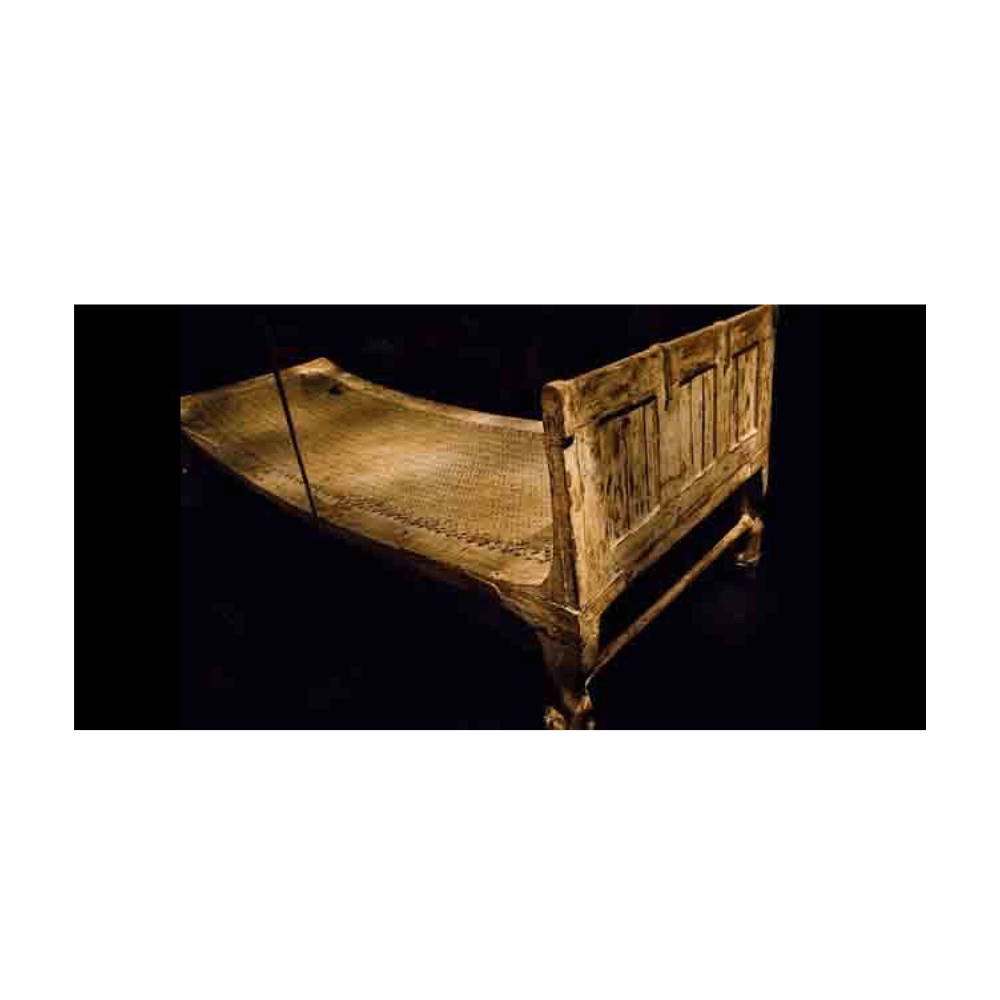
ANCIENT AFRICA
In addition to the prehistoric mattress found in KwaZulu-Natal, ancient Africa had diverse sleep practices. Tribes and communities used various materials for their bedding, such as grass, animal hides, and soft plant fibers. These materials provided comfort and insulation during sleep, adapting to the local climate and conditions.

- ANCIENT ARABIC AND MIDDLE-EASTERN
Ancient Arabic and Middle Eastern sleep history has unique characteristics. In ancient times, sleep in the region was influenced by cultural practices and Islamic traditions. According to legend, the first waterbed was developed in Persia more than 3,600 years ago and consisted of water-filled goatskins.
The water was thought to have therapeutic properties and to help people sleep more comfortably. The first modern waterbed was invented in 1965 by California inventor Charles Halladay. Halladay's waterbed was made from a vinyl-lined canvas bag filled with water.
Sleeping arrangements often involved low wooden beds or mats placed on the floor, emphasizing simplicity and modesty.
Privacy and comfort were valued, with expensive curtains and soft bedding materials like wool or cotton. These cultural elements contributed to the distinct sleep culture of the region.
The growing interest in health and safety brought attention to mattress certifications, which ensure materials are non-toxic, sustainably sourced, and ideal for sensitive sleepers.
ANCIENT GREEKS
Wealthy Greeks had more than one Kline; the Klines were couches with a raised headboard for reclining, eating, and sleeping. Some Klines were ornately decorated and upholstered with rich materials.
- ANCIENT ROME (CIRCA 1,000 B.C. TO 476 A.D.)
Ancient Rome showcased the distinction between the sleep arrangements of the wealthier citizens and the commoners. Wealthy Romans slept on beds filled with wool strings or feathers, while commoners made do with mattresses filled with hay. This disparity in materials reflected the socioeconomic divide in Roman society.
- ANCIENT EASTERN SLEEP HISTORY: CHINA, JAPAN
Eastern world and culture have significantly impacted the development of beds and mattresses. For example, firm sleep surfaces are preferred in China. Meanwhile, in Japan, futons are commonly used for sleep, showcasing the unique preferences of Eastern cultures regarding beds and mattresses.
These cultural preferences also extend to other aspects of sleep, such as sleep locations and partners. For example, in some Eastern cultures, it is common for entire family or families to sleep together in one room, while in others, individuals may sleep in separate rooms.
This diversity of preferences and practices highlights the profound influence of culture on the development of beds and mattresses throughout history.
Medieval Europe Period
(5th Century - 13th Century)
In medieval Europe, they introduced wooden beds and mattresses filled with straw or similar substances. Wealthier individuals in the Middle Ages enjoyed beds stuffed with soft, downy feathers, while the less fortunate had simpler bedding materials.
Hang curtains enclosing all parts of beds provided privacy and protection from drafts for people of lower socioeconomic status.
Medieval Europe Period: The Shift to Monophasic Sleep
- Transition from Biphasic to Consolidated Sleep
- During Medieval Europe, Consolidated sleep became more prevalent, influenced by social and cultural changes.
- Introducing artificial light, such as candles and lamps, contributed to the shift in sleep patterns.
- The Persistence of First and Second Sleep
- First and second sleep persisted in some regions, with individuals waking up for activities at night.
- This sleep structure balanced rest and wakefulness, eventually fading with modern sleep habits.
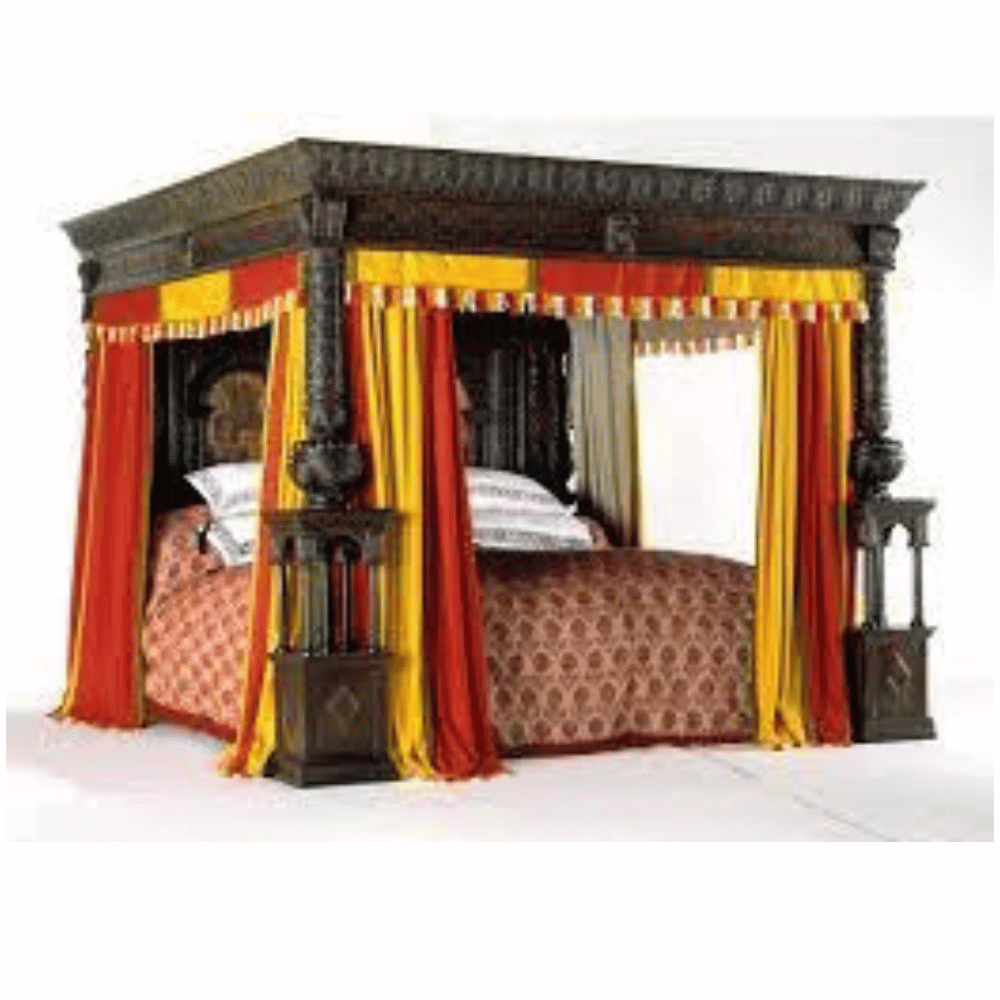
The Renaissance (14th Century - 17th Century)
The Renaissance period is generally considered to have spanned the 14th to the 17th centuries. During the era of King Louis XIV, beddings like the four-poster bed became more ornate and elaborate.
They were considered prized possessions. Four-poster beds with wood-paneled headboards and canopies supported by ropes or wool straps were popular. Socioeconomic status continued to influence sleep arrangements, with the wealthy owning intricately carved beds and thick, down-filled beds.
Curtains were commonly used in bedrooms for privacy and protection from drafts. They were hung around beds to create separate spaces within the same room.
With the increase in sleep-related disorders, mattress recommendations tailored for sleep conditions have become more prominent, integrating pressure-relieving materials and zoned support to improve rest quality.
Enlightenment Period
( 18th Century)
During the Enlightenment, bed materials and support systems innovations emerged in the 18th century. Wool cushions, metal bed frames, and bedsprings were invented, replacing ropes or wool straps and providing enhanced support and comfort. This era laid the foundation for modern mattress designs and our wide range of options.
Enlightenment Period: The Systematic Study of Sleep
- Exploration of Sleep's Physiological Aspects
- The Enlightenment period marked the beginning of systematic sleep studies, focusing on sleep's physiological and psychological aspects.
- Sleep medicine and establishing sleep centers allowed for better diagnosis and treatment of sleep disturbances.
- Development of Tools to Measure Sleep
- Researchers introduced methods to measure sleep, including using electrical mental activity to analyze sleep stages.
- The study of sleep latency, sleep hangover, and other phenomena provided valuable insights into sleep mechanisms.

Modern History
- (19TH CENTURY; 20TH CENTURY - 21ST CENTURY)
Western cultures have also considerably affected the design and materials utilized in beds. This includes using wood, metal frames, and other materials to fabricate beds and other materials for comfort and aesthetics. In the modern world, the four-poster bed was still used in the 19th and 20th centuries but was less common than in previous centuries.
19TH CENTURY
The 19th century witnessed a shift towards less ornate beds. Metal bed frames gained popularity due to their durability and affordability. Western European cultures influenced the design and materials used in beds during this period, introducing metal frames as a viable alternative to traditional wooden frames.
Although still used, the poster bed has become less common than in previous centuries. Scottish inventor John Boyd Dunlop invented the first latex mattress in 1888. Dunlop is best known for inventing the pneumatic tire, but he also invented the first latex bed from the sap of rubber trees.
Once limited to hay or rope beds, today’s sleepers can enjoy custom and adjustable mattresses that respond to body type, position, and firmness needs.
- MODERN HISTORY: ADVANCES IN SLEEP RESEARCH AND MEDICINE
- Technological Advances in Sleep Studies
- Sleep research in modern history has advanced with technologies like the multiple sleep latency test and sleep studies.
- Understanding sleep architecture, with REM and Quiet sleep, has advanced the diagnosis and treatment of sleep dysfunctions.
- The Role of Organizations in Promoting Sleep Awareness
- The National Sleep Foundation and other organizations have played an important role in raising awareness about sleep's importance.
- Ongoing research continues to explore molecular mechanisms and genetic factors influencing sleep patterns.
- 20th Century until World War II Time Period.
During the 20th century, mattress materials evolved, incorporating technologies such as coil springs and cotton batting—the 19th c. The Industrial Revolution led to mass production, making beds more accessible to the general population.
Cultural distinctions within Western cultures continued to influence sleep habits and preferences, with variations in sleeping arrangements, such as sleeping alone or with a partner or families in multiple rooms or beds.
In the second half of the 20th century, the study of sleep saw a dramatic rise, driven by research in internal medicine, molecular biology, and clinical sleep medicine.
For the first time, scientists began understanding the science behind REM and NREM sleep, uncovering its deep connections to psychiatric disorders, cardiovascular disease, and the regulation of cerebrospinal fluid.
- 21st Century:
There are many mattress options to suit every preference in this century. Modern mattresses incorporate advanced materials such as memory foam, latex, and hybrid designs.
In this century, there are many mattress options in the modern era to suit every preference. Modern mattresses
- 21st Century:
I am thrilled that many mattress options suit every preference in this century. Modern mattresses incorporate advanced materials such as memory foam, latex, and hybrid designs.
Sleep technology has also advanced, with innovations like adjustable bases, cooling features, and smart sleep trackers. Cultural influences and sleep practices worldwide have significantly shaped the design and comfort of contemporary beds.
The evolution of beds and sleep throughout history reflects the impact of socioeconomic factors, cultural practices, and technological advancements.
Section 3: Innovations in the Mattress Market and Industry
The mattress industry has seen many innovations over the years, particularly during the 20th century, with each new development aiming to provide a more comfortable and supportive sleep experience. Some of the most notable innovations include innerspring mattresses, memory foam beds, and latex beds. These advancements in the 20th century have revolutionized our sleep, offering various options for individual preferences and needs.
In addition to these innovations, the mattress market and industry have also seen the emergence of hybrid beds, airbeds, and waterbeds. These unique bed options cater to various sleeping preferences and mattress sizes.
TECHNICAL AND MEDICAL ADVANCEMENT IN SLEEP
- The Rise of Continuous Positive Airway Pressure (CPAP)
In the last few years, sleep medicine has witnessed a groundbreaking advancement with the introduction of Continuous Positive Airway Pressure (CPAP) machines.
This technology has revolutionized the treatment of obstructive sleep apnea, a condition where breathing repeatedly stops and starts during sleep.
- Continuous Positive Airway Pressure (CPAP) devices are now essential for individuals with sleep apnea.
- These devices improve breathing during sleep, improving sleep quality.
CPAP machines work by delivering a steady stream of air through a mask, keeping the airways open and ensuring uninterrupted breathing
. This innovation has improved sleep quality for countless individuals and reduced the health risks associated with sleep apnea, such as heart disease and stroke.
The emergence of mattress toppers added another chapter to sleep innovation, offering adjustable comfort and pressure relief atop traditional spring or foam-based mattresses.
- THE EMERGENCE OF SLEEP LABS
The establishment of sleep labs represents a significant leap in the practice of sleep medicine.
These specialized centers, which have become more prevalent in the second half of the last century, are dedicated to studying and treating sleep dysfunctions.
- Sleep labs contribute to understanding sleep disturbances, influencing the design of mattresses that address specific sleep needs.
- Mattresses designed for sleep apnea and poor sleep have emerged, highlighting the impact of medical advancements.
The National Center on Sleep Disorders Research, NHLBI, NIH, supports research, technology innovation, training, and health education in sleep irregularities.
In a sleep lab, patients undergo comprehensive evaluations, including polysomnography, to monitor various physiological parameters during sleep.
This allows for accurate sleep disorder diagnoses and effective treatment plans for various sleep disturbances beyond sleep apnea. The growth of sleep labs underscores the increasing recognition of the importance of sleep health in overall well-being.
- Addressing Daytime Somnolence and Shift Work
Another critical area of focus in recent sleep medicine advancements is the management of daytime sleep, especially among individuals working in two shifts.
Shift work can significantly disrupt the natural sleep-wake cycle, leading to sleep disturbances and excessive daytime sleepiness. Understanding the impact of irregular sleep patterns has become crucial in developing strategies to mitigate these effects.
This includes educating shift workers on sleep hygiene and exploring potential treatments to align their biological clocks with their work schedules.
The attention to these aspects highlights the evolving understanding that sleep matters in all facets of life, influencing both health and productivity.
Comparing Mattresses Throughout History
According to many sources, mattresses today play a vital role in clinical outcomes related to sleep health. As our understanding deepens, the mattress remains one of the most essential tools in promoting restorative sleep worldwide.
(Innerspring, Latex, Memory Foam)
Heinrich Westphal is credited with inventing the innerspring mattress in the late 19th century. Innerspring mattresses contain a system of metal coils or springs that provide support, offering a significant improvement over previous bed designs. Early innerspring beds utilized wool, down, or horsehair to encase the steel coil springs, ensuring comfort and support.
- Early Mattresses: Simple and Uncomfortable
- Historical mattresses were often made from straw or feathers, providing minimal comfort and support.
- As sleep research progressed, mattress technology evolved to offer greater comfort and support.
- Modern Mattresses: Addressing Specific Sleep Needs
- Modern mattresses, made from memory foam and latex, cater to various sleepers with various needs.
- The evolution of mattresses reflects advancements in sleep technology, improving sleep quality over time.
Even centuries ago, supportive bed structures mattered; today, bed frame assembly plays a crucial role in enhancing mattress longevity, airflow, and ergonomic performance.

Innerspring mattresses have undergone several alterations, incorporating additional padding around the coils to enhance comfort. They gained popularity in the 1930s when the first box springs, springs, and spring platforms were developed for mattress support.
Today, the innerspring bed and the box spring remain popular due to their durability, support, ventilation, and general affordability compared to other mattress types.
NASA initially developed memory foam in the 1970s for airline seat cushioning and crash protection. The first memory foam mattress was introduced to the US market by TempurPedic in 1992, and it quickly gained popularity due to its ability to reduce pressure points and provide a comfortable sleeping surface.
Memory foam mattresses have high customer satisfaction, making them a popular choice for many individuals. Since their initial release, memory foam mattresses have undergone advancements in durability, breathability, and safety. As technology evolves, memory foam beds will likely continue to improve.
- Mattresses for Daytime Somnolence
- Innovations in mattress design focus on reducing daytime sleepiness and improving sleep quality for those with sleep issues.
- Mattresses that enhance sleep regulation are particularly beneficial for individuals experiencing excessive daytime sleepiness.
Latex mattresses have a rich history, with John Boyd Dunlop's invention of latex foam dating back to the 1920s. The first latex mattress was produced in 1931, and since the 1940s, latex foam beds have been in use, becoming popular in the 1950s and 1960s. Latex beds offer a unique combination of comfort and support and are more resilient than traditional beds.
- Solutions for Shift Workers
- Shift work disrupts body clock, but specially designed mattresses help regulate sleep and wakefulness during the day.
- These mattresses promote better sleep for night-shift workers, ensuring a good night's sleep even during daylight hours.
Despite their initial popularity, latex beds experienced a decline in demand due to the affordability of memory foam mattresses.
However, latex beds have recently experienced a resurgence in popularity, largely due to their longevity and the growing demand for natural, eco-friendly materials.
As the bed market and industry evolve, latex beds remain viable for those seeking comfort, durability, and sustainability in their sleeping arrangements.
Materials like bamboo and reclaimed wood reflect a return to natural sleep solutions, echoing ancient construction with modern sustainability in mind.
Section 4: Mattress Trends Today:
(Bed Frames, Hybrid, Latex, and Memory Foam Mattress)
The mattress industry has recently seen a surge in new trends and innovations. Among these modern trends are hybrid beds, airbeds, waterbeds, and eco-friendly materials in mattress construction. These contemporary mattress options cater to a diverse range of sleeping preferences, allowing individuals to find one bed with the perfect balance of comfort and support for their unique needs.
The rise of online sales and the emergence of new mattress brands, such as Casper, Leesa, and Tuft & Needle, have also contributed to the ever-evolving landscape of the market and industry.
- Mattresses Designed for Sleep Onset and Latency
- Recent research has led to the development of mattresses that reduce sleep hangover and promote faster sleep onset.
- These mattresses are especially beneficial for individuals with sleep dysfunctions, enhancing overall sleep quality.
- The Role of Circadian Rhythms in Mattress Design
- Understanding Body clock has influenced the design of mattresses that promote better sleep regulation.
- Some mattresses have technologies that mimic natural light cycles, synchronizing the body's circadian clock.
As sleep needs evolved across different countries, standardized options emerged, and this mattress size chart guide helps visualize how bed dimensions adapted to modern space and comfort requirements.

- Mattress Sizes and Innovation:
Different mattress sizes were invented to meet the needs of different people and sleep arrangements. The first standard mattress sizes were invented in the early 1900s, larger sizes in the mid-1900s, and the split California king in the late 1990s.
THE MAJOR CONTRIBUTION OF HYBRID MATTRESSES IN THE HISTORY OF SLEEP
- Comfort and Support
Hybrid mattresses have significantly contributed to the history of sleep by revolutionizing the concept of comfort and support in bed.
y combining different materials such as foam, latex, and innerspring coils in a multi-layered bed design, the bed offers a unique sleep experience.
Integrating multiple materials into platform beds allows for a balance between contouring comfort and responsive support.

- Versatility and Adaptability
One of the key contributions of hybrid beds is their versatility and adaptability. Combining various materials enables hybrid mattresses to provide a customized sleep surface that caters to individual preferences.
With different layers and varying firmness levels, individuals can choose a hybrid mattress that suits their needs, whether they prefer a plush feel or firmer support. This versatility ensures that hybrid beds can accommodate a broader range of sleepers.
- Continuous Innovation
Hybrid beds have sparked a wave of innovation in the market and industry. Their success has prompted manufacturers to continually refine and improve the design and materials used in hybrid beds.
This ongoing innovation has led to advancements in foam technology, coil systems, and the integration of new materials, resulting in even more comfortable and supportive sleep surfaces. Hybrid beds have pushed the boundaries of sleep technology, inspiring other mattresses to incorporate similar hybrid approaches.
Scientific Discoveries About Sleep: A Modern Understanding
Scientific research has dramatically expanded our understanding of sleep, unraveling the complexity of the sleeping brain and the various processes that occur during rest.
The study of brain wave patterns has been particularly illuminating, revealing how these patterns shift as we transition from wakefulness to sleep.
This journey begins with wakefulness and leads into NREM (Non-Rapid Eye Movement) sleep, a critical phase for physical restoration and overall well-being. Additionally, exploring sleep hygiene and its role in maintaining a healthy circadian rhythm has become a focal point for ensuring adequate and restorative sleep.
- BRAIN WAVE PATTERNS AND NREM SLEEP
- The transition from Wakefulness to Sleep
- Brain wave patterns undergo significant changes as we move from wakefulness into the initial stages of sleep.
- The brain gradually shifts from beta waves, which dominate during wakefulness, to alpha waves and the slower theta waves, which characterize sleep onset.
- Quiet sleep is particularly crucial as it involves the slow-wave sleep stage, essential for physical repair and regeneration.
- The Importance of Quiet Sleep
- NREM sleep is a vital phase where the body repairs tissues, strengthens the immune system, and consolidates memories.
- During Quiet sleep, the brain's activity slows down, allowing for deep, restorative rest, essential for overall health.
- Disruptions in Quiet sleep can lead to various health issues, including impaired cognitive function, increased stress levels, and chronic fatigue.
SLEEP HYGIENE AND CIRCADIAN RHYTHMS
Maintaining proper sleep hygiene is vital for regulating the body's circadian rhythm (the internal clock that governs the sleep-wake cycle). Circadian rhythms are affected by external factors like light, temperature, and lifestyle habits.
Good sleep hygiene practices, like a regular sleep schedule, having a conducive sleep environment, and limiting exposure to screens before bed, help align the circadian rhythm with natural sleep patterns. When these rhythms are in sync, individuals are more likely to achieve restful and uninterrupted sleep, which is crucial for overall well-being.
- Key Practices for Good Sleep Hygiene
- Consistent sleep schedule: Going to bed and being able to wake up at the same time each day helps regulate the circadian rhythm.
- Creating a sleep-conducive environment: A dark, quiet, and cool room can significantly improve sleep quality.
- Limiting screen time before bed: Reducing your exposure to blue light from screens helps the brain prepare for sleep by allowing melatonin production to increase naturally.
- Impact of External Stimuli on Sleep
- External factors, such as noise, light, and temperature, can disrupt sleep patterns and badly affect sleep quality.
- Creating a calming pre-sleep routine, such as reading or meditation, can mitigate the impact of external stimuli on sleep.
THE CONCEPT OF BIPHASIC SLEEP
Biphasic sleep, the practice of sleeping in two distinct phases, has historical roots and aligns with natural body clock.
This sleep pattern, which often involves a first sleep in the evening and a second sleep in the early morning, optimizes rest and allows individuals to experience a balance between deep, restorative sleep and lighter stages of sleep.
While modern lifestyles have shifted towards Consolidated sleep, where individuals sleep in one long stretch, biphasic sleep may benefit some, particularly in cultures where this pattern is still prevalent.
Sleep Inertia and the Need for Eight Hours of Sleep
- Understanding Sleep Hangover or Inertia
- Sleep hangover or Inertia refers to the grogginess and disorientation that individuals often feel upon waking, particularly if they are awakened during the deeper stages of sleep.
- This phenomenon is more pronounced when individuals do not get the recommended eight hours of sleep, as the body has not completed its natural sleep cycle.
- The Importance of a Full Night’s Sleep
- Achieving eight hours of sleep is critical for minimizing sleep hangover and restoring the body and brain fully.
- Research shows that individuals who consistently get eight hours of sleep are more alert, have better cognitive function, and experience fewer health issues.
THE ROLE OF SLEEP CENTERS AND CONTINUED RESEARCH
Sleep centers have played a pivotal role in advancing our understanding of sleep by providing a controlled environment for studying sleep patterns and disorders.
These centers use similar approaches, such as polysomnography, to measure and analyze various aspects of sleep, including brain wave activity, eye movements, and breathing patterns.
The data collected from sleep studies conducted in these centers have been instrumental in identifying sleep issues like sleep apnea, insomnia, and narcolepsy.
The continued research facilitated by sleep centers has laid the foundation for modern sleep science, offering valuable insights into how and why we sleep and guiding the development of effective treatments for sleep-related issues.
- Key Contributions of Sleep Centers
- Sleep centers conduct in-depth studies on various sleep irregularities, contributing to better diagnosis and treatment.
- The research from these centers has led to significant advancements in sleep medicine, improving the quality of life for individuals with sleep disturbances.
- The Future of Sleep Research
- Ongoing research aims to uncover more about the complexities of sleep, including the role of genetics and environmental factors.
- As our understanding of sleep deepens, new approaches to enhancing sleep quality and treating sleep issues will continue to emerge.
Scientific discoveries about sleep have revolutionized our understanding of this essential biological process, highlighting its complexity and critical role in health and well-being.
From the study of brain wave patterns to the development of sleep centers, each advancement has brought us closer to fully understanding how and why we sleep, paving the way for continued research and innovation in the field of sleep science.
Understanding and Diagnosing Sleep Disorders
- The Spectrum of Sleep Disorders
Sleep irregularities involve many conditions that affect sleep quality, timing, and duration, impacting overall health and well-being.
Common sleep disturbances include obstructive sleep apnea, characterized by repeated breathing interruptions during sleep, and insomnia, marked by problems of falling asleep or staying asleep.
Other sleep issues, like narcolepsy and restless legs syndrome, also significantly disrupt any normal sleep pattern of eight hours. Understanding these disorders is crucial for effective treatment and disease control.
- The Role of Sleep Studies in Diagnosing Disorders
- Sleep studies conducted in sleep centers are essential for diagnosing sleep irregularities like sleep apnea and insomnia.
- These studies analyze brain waves, heart rate, and physiological changes, providing insights into underlying sleep issues.
- Mattresses Tailored to Specific Sleep Issues
- The increased focus on diagnosing sleep issues has created mattresses that address specific conditions.
- These tailored solutions offer personalized comfort and support, improving sleep quality for individuals with unique sleep needs.
- Diagnosing Sleep Apnea and Its Variants
Obstructive sleep apnea (OSA) and central sleep apnea are the two main types of sleep apnea, with OSA being more common.
These conditions are characterized by pauses in breathing or shallow breathing during sleep, which can lead to sleep disturbances and excessive sleepiness during the day.
Diagnosing sleep apnea typically involves a sleep study or polysomnography, which records various physiological functions during sleep, such as mental activity, eye movements, and breathing patterns.
The multiple sleep latency test is another diagnostic tool for assessing daytime sleepiness.
- The Role of REM Sleep and Sleep Stages in Disorders
Rapid Eye movement (REM) sleep and slow wave sleep are critical sleep cycle stages. REM stage is associated with vivid dreams and is thought to play a role in memory consolidation and emotional regulation.
Disorders affecting REM sleep, such as REM sleep behavior disorder, can lead to physical movements during dreaming and disturbed sleep.
Slow-wave sleep, or deep sleep, is essential for physical restoration. Disruptions in these stages can lead to various sleep problems, including segmented sleep and pathological sleep patterns.
- The Impact of Sleep Disorders on the Nervous System
Sleep disturbances can have a profound impact on the nervous system. Conditions like sleep deprivation and chronic insomnia can lead to cognitive impairments, mood disturbances, and an increased risk of neurological disorders.
Lesion studies and research into the neurobiology of sleep have provided insights into how sleep issues affect the brain and nervous system.
This research is essential for developing effective treatment options for sleep-related neurological issues.
Historically, people slept on firm surfaces like straw mats or wood; the Plank Mattress channels this ancient wisdom with modern orthopedic support.
The Effects of Sleep Deprivation
Sleep deprivation disrupts the delicate balance of total sleep time required for proper recovery, leading to decreased brain performance.
Ensuring conditions that support easy transition to sleep, such as creating environments that help individuals fall asleep quickly and sleep longer, can mitigate these effects.
Sleep medicine continues to explore how sleep and circadian rhythms influence brain health, with the goal of promoting better sleep habits for overall well-being.
- Modern Approaches to Treating Sleep Disorders
The treatment of sleep disturbances has evolved significantly over the years. Continuous positive airway pressure (CPAP) therapy is a popular and effective treatment for obstructive sleep apnea.
Other treatment options for various sleep disturbances include behavioral therapy, medication, and lifestyle changes. Sleep issues centers are crucial in providing comprehensive care, from diagnosis to treatment, ensuring that patients with sleep disturbances receive the most appropriate and effective interventions.
As our understanding of sleep and wakefulness deepens, so does our ability to offer more targeted and effective treatments for those suffering from sleep disturbances.
Section 5: The Future of Sleep and Mattresses
Throughout sleep history, the evolution of beds and mattresses has been shaped by various factors, including cultural influences, technological advancements, and changing consumer demands. In this context, smart and adjustable beds represent the latest innovations contributing to sleep's evolution.
Smart mattresses with advanced technology features integrate seamlessly into the sleep experience. They offer a range of functions, such as sleep tracking, temperature control, adjustable firmness, and connectivity options. By incorporating these features, smart beds aim to provide personalized comfort and optimize sleep quality.
- Next-generation mattresses with Integrated Sensors
- Future mattresses may have sensors that monitor sleep patterns and adjust firmness or support based on user needs.
- These innovations will likely enhance sleep quality by providing personalized sleep experiences.
- Regulating Sleep Through Circadian Modulation
- Advances in understanding circadian modulation may lead to mattresses that enhance sleep regulation and overall health.
- These mattresses could synchronize with the body's natural rhythms, promoting better sleep and well-being.
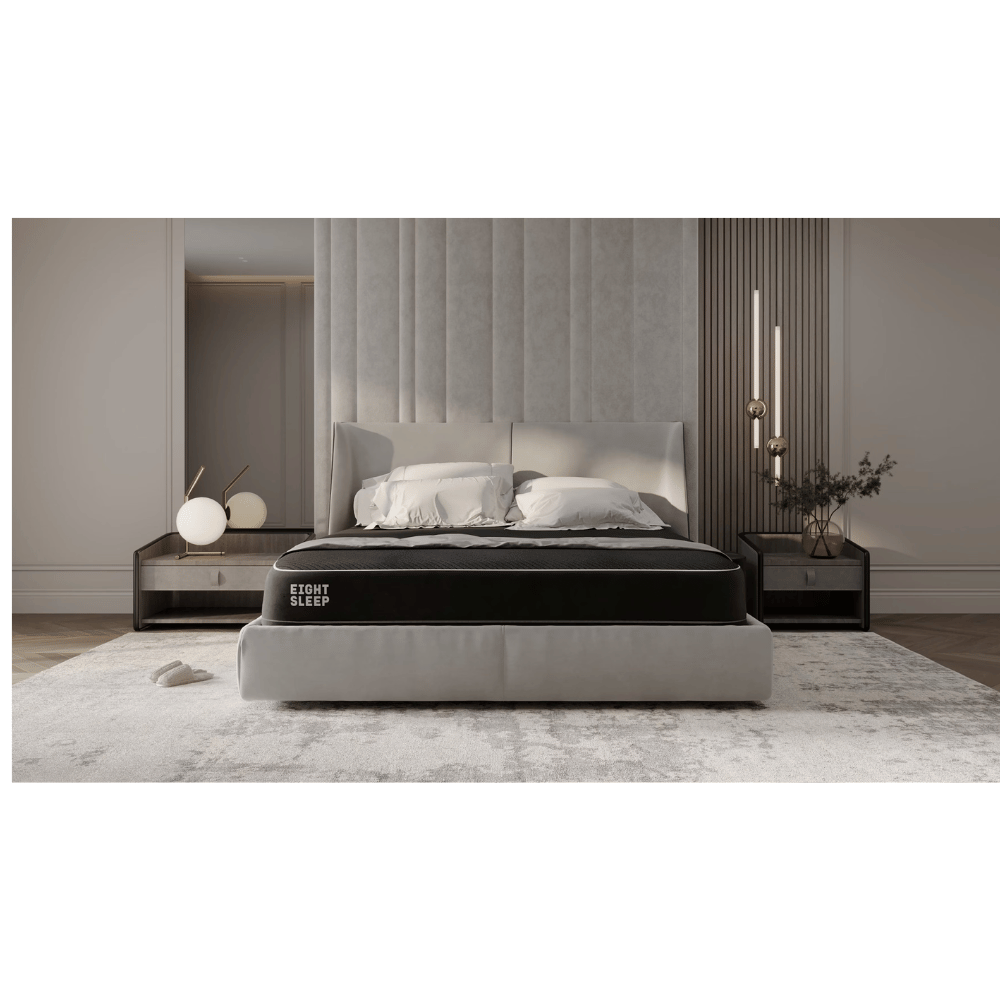
On the other hand, adjustable beds focus on the positioning and customization of the new bed and sleep surface.
With motorized bases, these bed users can adjust the angle and elevation of the bed in different sections, offering versatile options for reading, watching TV, or finding the most comfortable sleep position.
Adjustable beds provide enhanced support and can help alleviate certain health conditions.
Both smart mattresses and adjustable beds represent the latest advancements in the quest for improved sleep. They showcase technology's influence in meeting sleepers' evolving needs and preferences.
The Role of Artificial Intelligence in Sleep and Mattress Technology
- Ai-driven mattresses for Personalized Sleep
- Artificial intelligence may revolutionize sleep technology by offering mattresses that adjust in real-time to improve sleep quality.
- AI-driven mattresses could monitor sleep stages and adjust automatically for optimal comfort and support.
- The Future of Personalized Sleep Solutions
- Integrating AI with sleep research could lead to a new era of personalized sleep solutions tailored to individual needs.
- These advancements promise to improve sleep quality and promote health and well-being.
Unlike past centuries, modern mattress shopping includes generous trial periods and warranties that offer customers confidence, flexibility, and satisfaction guarantees.

Summary
The history of sleep and mattresses is truly fascinating.
From early makeshift beds to luxurious modern mattresses, we see how our quest for comfort has evolved.
As we embrace new technologies and adapt to changing consumer demands, the future of sleep and mattresses promises to be even more exciting.
Let’s work together to create a future where everyone can enjoy the perfect night's sleep.
Join me in exploring how we can continue improving our rest.
FAQs
How has the mattress changed over time?
Over time, the traditional mattress has become more advanced and comfortable. From thinner mattresses in the 1980s and 1990s that suffered from motion transfer issues, recent advancements have seen the average mattress height increase considerably, allowing for improved durability and comfort.
This has resulted in a much more comfortable sleep experience, with most mattresses now offering superior support and pressure relief. Additionally, using advanced materials, such as memory, is an advantage.
What is the brief history of mattresses?
Mattresses have a long and rich history. The first mattress was believed to have been created by humans living in Sibudu Cave in KwaZulu-Natal, South Africa, around 77,000 years ago. This ancient mattress was made of layers of plant material and grasses for bedding.
What did people sleep on before modern mattresses?
People have been sleeping on mattresses for centuries, though what constitutes a comfortable mattress has drastically changed. Before modern mattresses, people typically used soft bedding materials such as reeds, rushes, leaves, straws, woven mats, and cloth sacks filled with hay. This provided a more comfortable environment than people sleeping directly on the ground.
